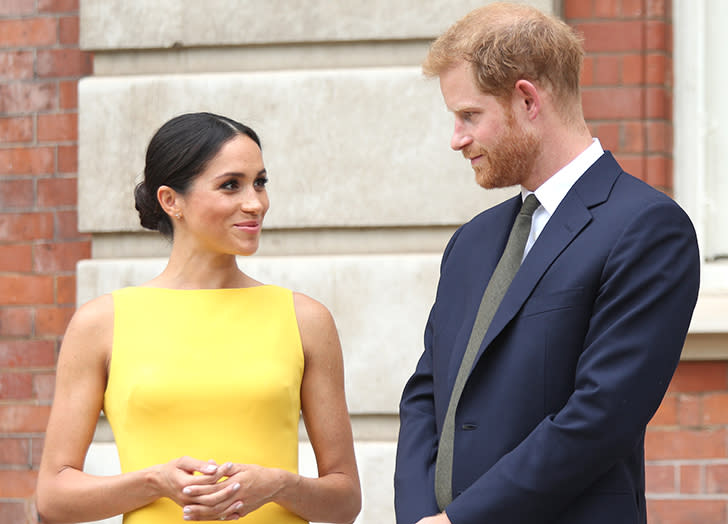*Another* Royal Is Moving to the United States, Just Like Prince Harry & Meghan Markle - Yahoo Ca... - 4 minutes read

Eat This, Not That!
Year two of the pandemic, you'd assume that most of us would be pretty educated about COVID-19 by now. But our knowledge and understanding of SARS-CoV-2 have grown, and so has misinformation. As a doctor and immunotherapy scientist, I've put together this essential list of the top 5 scientifically proven ways COVID really spreads. Read on—and to ensure your health and the health of others, don't miss these Signs Your Illness is Actually Coronavirus in Disguise. 1 COVID is in the Air COVID-19 spreads from person to person, most commonly by respiratory "droplets," large clumps of virus formed when someone coughs, sneezes, speaks, yells, cries, eats or blows their nose. The tiniest droplets, known as "aerosols," can stay in the air for hours after they've been projected from a person's nose and mouth. The virus can linger in the air waiting for the next person to breathe them in and become contaminated with SARS-Cov-2. The most prudent way to think of respiratory viruses is that they are in the air, and it is your job to prevent yourself from inhaling them. How? By wearing N95 masks, double masking, and not sharing someone's air. 2 Time of Exposure Matters There is a point at which the "dose" of virus you inhale allows you to become infected. As a result, the amount of time you spent at an indoor venue and the time you were exposed to someone potentially sick matters. The general rule is that the more you are exposed to something, the more likely you are to become infected. You are much more likely to be infected by covid if you spend hours in a crowded bar than if you spend minutes in a socially distant store. 3 Ventilation is Crucial Don't share your air. Don't breathe someone's air. Opening windows while spending time indoors helps remove COVID aerosols. Windows greatly facilitate this air exchange, eliminating old air and letting in new, clean air. This is tightly controlled in newer hospitals, with air filters cycling the air 4–5 times an hour or more. COVID particles are easily diluted and dissipated in the open air, much like smoke, but indoors remains to be the most likely place to catch COVID. COVID is mainly in the air. Good ventilation is critical to prevent new cases. Ventilation quality is measured by how long the same old air in a room is swapped for fresh new air. Restaurants/schools/labs should have high-quality HVAC systems. 4 Masks are not Political. They Can Save Your Life—and the Lives of Others Our personal actions protect us from getting sick. From wearing high-quality masks, which restrict aerosol, to social distancing, which decreases the number of people in the range of any manufactured aerosols, these easy and cheap measures literally save lives. You cannot control someone next to you from shouting, but remember, the aerosol output is increased by talking loudly. Concerts and bars are still a bad idea. 5 Clean Hands Means No Handshakes At the beginning of the pandemic, we thought dirty or contaminated surfaces could amplify COVID's spread. This appears to be less likely than previously thought. But washing your hands with alcohol gel or soap effectively destroys the virus and will prevent you from spreading it to others by touching them. To keep your hands clean, remember not to go out touching other people's hands, especially if you don't know what they were touching. I left handshakes in 2020 and hope they never come back. It's not hygienic, and you can bond and connect with people you work with or colleagues without touching them. COVID is also present in the urine and flatulence. Now, scientists have been testing COVID-19 levels in the sewage system to assess the implications of this in the outbreak. RELATED: Signs You're Getting One of the "Most Deadly" Cancers 6 Get Vaccinated and Stop the Spread Follow Dr. Anthony Fauci's fundamentals and help end this pandemic, no matter where you live—wear a face mask that fits snugly and is double layered, don't travel, social distance, avoid large crowds, don't go indoors with people you're not sheltering with (especially in bars), practice good hand hygiene, get vaccinated when it becomes available to you, and to protect your life and the lives of others, don't visit any of these 35 Places You're Most Likely to Catch COVID.Leo Nissola, MD, is an internationally recognized immunotherapy scientist and immunology researcher focused on drug development. Follow Dr. Leo Nissola on Instagram and Twitter .
Source: Yahoo Entertainment
Powered by NewsAPI.org